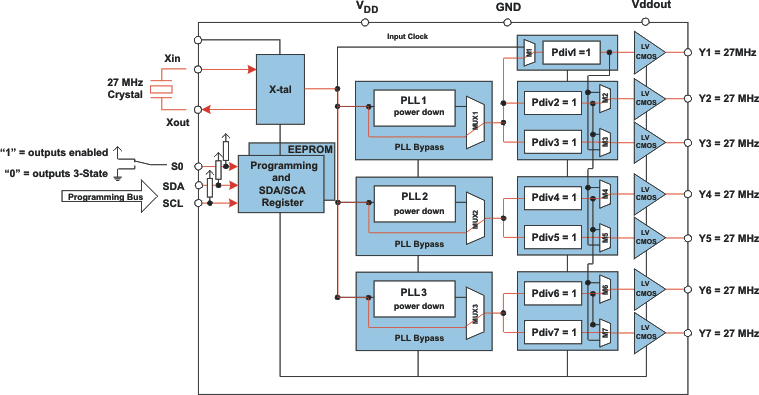SCAS844G August 2007 – January 2024 CDCE949 , CDCEL949
PRODUCTION DATA
- 1
- 1 Features
- 2 Applications
- 3 Description
- 4 Pin Configuration and Functions
- 5 Specifications
- 6 Parameter Measurement Information
- 7 Detailed Description
- 8 Application and Implementation
- 9 Register Maps
- 10Device and Documentation Support
- 11Revision History
- 12Mechanical, Packaging, and Orderable Information
Package Options
Mechanical Data (Package|Pins)
- PW|24
Thermal pad, mechanical data (Package|Pins)
Orderable Information
7.3.2 Default Device Setting
The internal EEPROM of CDCEx949 is preconfigured as shown in Figure 7-1 (the input frequency is passed through to the output as a default). This allows the device to operate in default mode without the extra production step of programming. The default setting appears after power is supplied or after power-down or power-up sequence until the setting is re-programmed by the user to a different application configuration. A new register setting is programmed through the serial SDA/SCL Interface.
 Figure 7-1 Default Device Setting
Figure 7-1 Default Device SettingTable 7-4 shows the factory default setting for the Control Terminal Register (external control pins). In normal operation, all 8 register settings are available, but in the default configuration only the first two settings (0 and 1) can be selected with S0, as S1 and S2 configured as programming pins in default mode.
| Y1 | PLL1 SETTING | PLL2 SETTING | PLL3 SETTING | PLL3 SETTING | |||||||||||
|---|---|---|---|---|---|---|---|---|---|---|---|---|---|---|---|
| EXTERNAL CONTROL PINS(1) | OUTPUT SELECT | FREQ. SELECT | SSC SEL. | OUTPUT SELECT | FREQ. SELECT | SSC SEL. | OUTPUT SELECT | FREQ. SELECT | SSC SEL. | OUTPUT SELECT | FREQ. SELECT | SSC SEL. | OUTPUT SELECT | ||
| S2 | S1 | S0 | Y1 | FS1 | SSC1 | Y2Y3 | FS2 | SSC2 | Y4Y5 | FS3 | SSC3 | Y6Y7 | FS4 | SSC4 | Y8Y9 |
| SCL (I2C) | SDA (I2C) | 0 | 3-state | fVCO1_0 | off | 3-state | fVCO2_0 | off | 3-state | fVCO3_0 | off | 3-state | fVCO4_0 | off | 3-state |
| SCL (I2C) | SDA (I2C) | 1 | enabled | fVCO1_0 | off | enabled | fVCO2_0 | off | enabled | fVCO3_0 | off | enabled | fVCO4_0 | off | enabled |